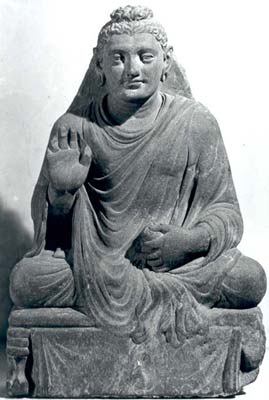


Notice: This is the official website of the All Empires History Community (Reg. 10 Feb 2002)
Hellenic influence on Buddhism |
Post Reply 
|
| Author | |
sreenivasarao s 
Samurai 
Joined: 02-Apr-2007 Location: India Online Status: Offline Posts: 115 |
 Quote Quote  Reply Reply
 Topic: Hellenic influence on Buddhism Topic: Hellenic influence on BuddhismPosted: 10-May-2007 at 15:28 |
|
Hellenic influence on Buddhism The interaction
between Hellenistic During these long years,
just as Buddhism spread its influence in the Hellenistic world particularly
around Some scholars opine
that Greek-Buddhist interaction lead to evolution of Mahayana branch of
Buddhism, introducing the �man-god� treatment of the Buddha as is done with
Hellenic gods. Further, the representation of Buddha in human form also appeared
to be an offshoot of Hellenic influence on Buddhism. Until around the
first century, the Wheel of the Law, his footprints, his umbrella, an empty
throne, or the Bo tree under which he attained Enlightenment
represented the Buddha. The human image of the Buddha was not projected either
in sculptures or in paintings. It was only after the advent of Ghandhara art
(of Greco-Roman origin that flourished largely during the Kushan
dynasty, to the
south of the These artists, while
retaining their classical conceptions of the human form presented to the world
a Greek-featured Buddha, dressed in a toga and seated in yoga pose. Thus, the
Gandharan style represented a union of classical Indian and Hellenic elements Apart from this
,while interpreting the Buddhist legends ( Jathaka tales), the Gandhara School
incorporated many motifs and techniques from classical Roman art, including
vine scrolls, cherubs bearing garlands, tritons, and centaurs. The Gandhar
craftsmen thus made a significant contribution to Buddhist art in their
depiction of events in Buddha�s life. The basic iconography, however, remained
Indian Albert Gruenwedel
(1856 -1935), a German Indologist, thought that Hellenic deities were traceable
in Ghandara art. According to him, Apollo served as the model for Buddha
images. The Gandhara school , he said , drew upon the anthropomorphic
traditions of Roman religion and represented the Buddha with a youthful
Apollo-like face, dressed in garments resembling those seen on Roman imperial
statues .He also remarked that the types of Ghandara school were traceable in Buddhist
religious paintings of Tibet , China and Japan. |
|
 |
|
Flipper 
Arch Duke 

Joined: 23-Apr-2006 Location: Flipper HQ Online Status: Offline Posts: 1813 |
 Quote Quote  Reply Reply
 Posted: 22-May-2007 at 02:45 Posted: 22-May-2007 at 02:45 |
|
I've seen amazing art, mixing Hellenic and Buddhist style. I'm interrested on the interaction between the two religions. Both were philosophically oriented and open to many things. The fact is that there are statues of gods sharing common characteristics from both, which means there must have been a wide acceptance of the holy elements from both sides.
|
|
 
Så nu tar jag fram (k)niven va! |
|
 |
|
sreenivasarao s 
Samurai 
Joined: 02-Apr-2007 Location: India Online Status: Offline Posts: 115 |
 Quote Quote  Reply Reply
 Posted: 22-May-2007 at 04:25 Posted: 22-May-2007 at 04:25 |
|
Yes Sir
Sorry I did not notice this thread . I was following the other post on the same page.. Regards |
|
 |
|
Leonidas 
Tsar 

Joined: 01-Oct-2005 Location: Australia Online Status: Offline Posts: 4613 |
 Quote Quote  Reply Reply
 Posted: 22-May-2007 at 09:12 Posted: 22-May-2007 at 09:12 |
|
i want to post some more on this topic. Great opening post BTW
a place to one can look for Hellenic-Buddhist interaction is around the time of ashoka. Im using wiki as a jump start, so dont crucify me but i came on late tonight. Try these links to ferret around the subject. Dharmaraksita a Greek Buddhist missionary http://en.wikipedia.org/wiki/Dharmaraksita http://en.wikipedia.org/wiki/Edicts_of_Ashoka#Greek_communities a bilingual Greek-armaic Ashoka edict from kandahar  Pictures of Hellenic influenced buddhist art, from http://en.wikipedia.org/wiki/Greco-Buddhism and it sources "One of the first known representations of the Buddha, Gandhara, in pure Hellenistic style and technique: Standing Buddha (Tokyo National Museum). Height: about 1 meter."  Kushan era buddha From http://www.exoticindiaart.com/article/buddhaimage  Greco buddhist art from gandhara (a Bodhisattva?) the next two from http://faculty.maxwell.syr.edu/gaddis/HST210/Oct21/Default.htm  Heracles in India  Edited by Leonidas - 22-May-2007 at 09:15 |
|
 |
|
sreenivasarao s 
Samurai 
Joined: 02-Apr-2007 Location: India Online Status: Offline Posts: 115 |
 Quote Quote  Reply Reply
 Posted: 25-May-2007 at 05:03 Posted: 25-May-2007 at 05:03 |
|
Great pictures
Thank you |
|
 |
|
Post Reply 
|
| Forum Jump | Forum Permissions  You cannot post new topics in this forum You cannot reply to topics in this forum You cannot delete your posts in this forum You cannot edit your posts in this forum You cannot create polls in this forum You cannot vote in polls in this forum |
Copyright ©2001-2009 Web Wiz
This page was generated in 0.078 seconds.











 Printable Version
Printable Version Google
Google Delicious
Delicious Digg
Digg StumbleUpon
StumbleUpon Windows Live
Windows Live Yahoo Bookmarks
Yahoo Bookmarks reddit
reddit Facebook
Facebook MySpace
MySpace Newsvine
Newsvine Furl
Furl Topic Options
Topic Options